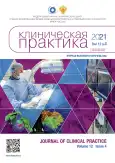Influence of common zones of low-amplitude activity on the mechanism and treatment of atrial arrhythmias
- Authors: Dedukh E.V.1, Artyukhina E.A.1
-
Affiliations:
- A.V. Vishnevsky National Medical Research Center of Surgery
- Issue: Vol 12, No 4 (2021)
- Pages: 86-91
- Section: Case reports
- URL: https://journals.rcsi.science/clinpractice/article/view/83495
- DOI: https://doi.org/10.17816/clinpract83495
- ID: 83495
Cite item
Full Text
Abstract
Background: The treatment of left atrial flutter is a problem that requires a deep understanding of the underlying complex mechanism of arrhythmia. Although a considerable experience exists already in understanding the mechanisms underlying atrial flutter after ablation or surgery, little is known about atypical forms of atrial flutter in patients who have not previously undergone ablation or other cardiac surgery.
Clinical case description: We present a clinical case of interventional treatment of a patient with atypical atrial flutter who had not previously undergone surgical or interventional heart surgery. This clinical observation demonstrates the role of common zones of low-amplitude activity on the mechanism and treatment of atrial arrhythmias. Widespread areas of low-amplitude activity in the left atrium can create barriers to the propagation of excitation, which can cause atypical atrial flutter.
Conclusion: When performing a surgical intervention, high-density mapping will help to visualize the mechanism of this arrhythmia. Understanding the mechanism of atypical atrial flutter will help to minimize the RF exposure during the treatment.
Full Text
##article.viewOnOriginalSite##About the authors
Elizaveta V. Dedukh
A.V. Vishnevsky National Medical Research Center of Surgery
Author for correspondence.
Email: dedukh.elizaveta@mail.ru
ORCID iD: 0000-0002-4799-7456
SPIN-code: 4433-7258
Graduate Student
Russian Federation, 27, Bolshaya Serpukhovskaya street, Moscow, 117997Elena A. Artyukhina
A.V. Vishnevsky National Medical Research Center of Surgery
Email: artelena.71@mail.ru
ORCID iD: 0000-0001-7065-0250
M.D., Ph.D., Dr. Sci. (Med.)
Russian Federation, 27, Bolshaya Serpukhovskaya street, Moscow, 117997References
- Gucuk IE, Marine J, Yang E, et al. Predictors and incidence of atrial flutter after catheter ablation of atrial fibrillation. Am J Cardiol. 2019;124(11):1690–1696. doi: 10.1016/j.amjcard.2019.08.026
- Markowitz SM, Thomas G, Liu CF, et al. Atrial tachycardias and atypical atrial flutters: mechanisms and approaches to ablation. Arrhythm Electrophysiol Rev. 2019;8(2):131–137. doi: 10.15420/aer.2019.17.2
- Cosío FG. Atrial flutter, typical and atypical: a review. Arrhythm Electrophysiol Rev. 2017;6(2):55–62. doi: 10.15420/aer.2017.5.2
- Coffey JO, D’Avila A, Dukkipati S, et al. Catheter ablation of scar-related atypical atrial flutter. Europace. 2013;15(3):414–419. doi: 10.1093/europace/eus312
- Siebermair J, Kochhäuser S, Kupusovic J, et al. Impact of previous left atrial ablation procedures on the mechanism of left atrial flutter: a single-centre experience. J Cardiovasc Electrophysiol. 2020;31(7):1631–1639. doi: 10.1111/jce.14505
- Frontera A, Takigawa M, Martin R, et al. Electrogram signature of specific activation patterns: analysis of atrial tachycardias at high-density endocardial mapping. Heart Rhythm. 2018;15(1):28–37. doi: 10.1016/j.hrthm.2017.08.001
- Goette A, Kalman JM, Aguinaga L, et al. EHRA/HRS/APHRS/SOLAECE expert consensus on atrial cardiomyopathies: definition, characterization, and clinical implication. Heart Rhythm. 2017;14(1):e3–e40. doi: 10.1016/j.hrthm.2016.05.028
- Giehm-Reese M, Lukac P, Kristiansen SB, et al. Outcome after catheter ablation for left atrial flutter. Scand Cardiovasc J. 2019;53(3):133–140. doi: 10.1080/14017431.2019.1612086
- Sundaram S, Choe W, Ryan JJ, et al. Catheter ablation of atypical atrial flutter: a novel 3D anatomic mapping approach to quickly localize and terminate atypical atrial flutter. J Interv Card Electrophysiol. 2017;49(3):307–318. doi: 10.1007/s10840-017-0269-z
Supplementary files












